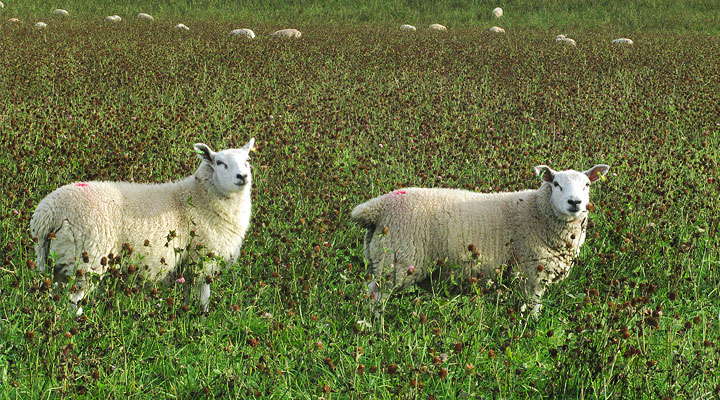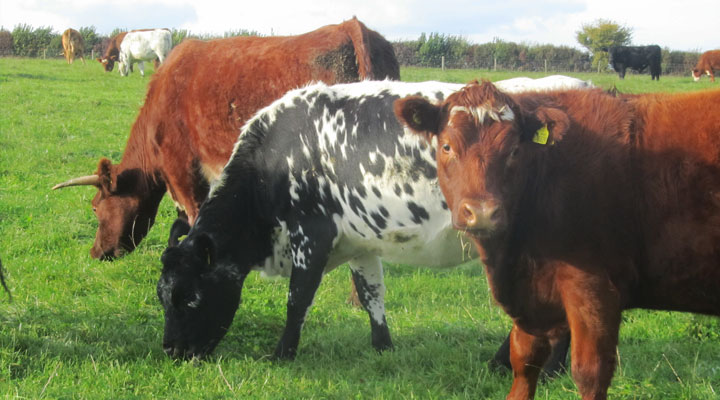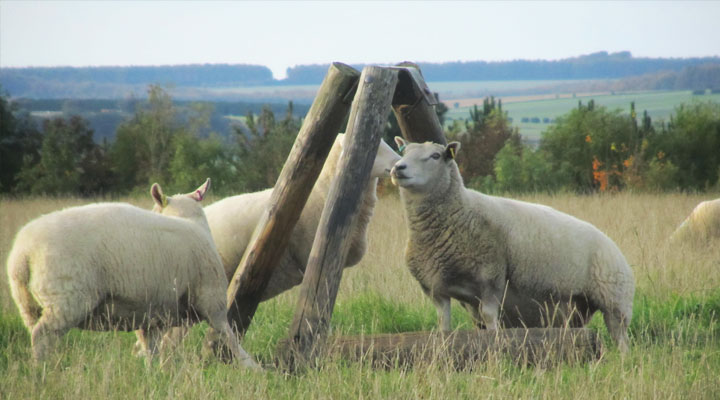Pasture for Life – Case Study – Dan Bull, Berkshire

Sheepdrove Organic Farm covers 1,012ha sitting on top of the Berkshire Downs above Lambourn. A herd of 480 suckler bred cattle, purebred Aberdeen Angus and Beef Shorthorn cows with a few British White cows, are mated with Beef Shorthorn bulls. The cows calve in two five-week blocks, in spring and in autumn. The bulls run with the spring calving cows at grass from June for two heats and with the autumn calvers from January.
The cows are ultrasound scanned 34 days after service. Any that are empty return to the bull for the next serving session. Those that fail to get in calf twice are culled, although fertility is generally good and this rarely happens.
Despite being on chalk, the cattle are housed in winter to stop any poaching of the grassland. Herbal ley silage and ad-lib high quality meadow hay are the only feeds offered to animals of all ages. Red clover silage is used to finish fattening stock.

The beef cattle are reared and finished off just pasture – no grain is ever fed, at between 18 and 25 months of age. Three carcases are hung for between four and five weeks and sold at either the Sheepdrove shop in Maida Vale in London, the dining room of the Eco Conference Centre situated on the farm, or via an Internet retail box scheme.
Sheepdrove’s flock of sheep has 40 pedigree and 100 purebred Shetland ewes at its centre, chosen for their keen mothering nature and ability to survive the harshest conditions. They are good for conservation grazing on hard to access chalk banks and are used to produce hogget and mutton.
The main commercial flock is made up of the small Shetlands crossed with a much larger Lleyn ram. These are then crossed again with a Lleyn or Texel to produce a finished lamb of 36kg liveweight. Thirty a week are drawn for slaughter. There are currently 1,000 ewes in the flock and the plan is to reach 2,000 by the end of next year.
There are 688ha (1,700 acres) of cultivatable area, under a six-year rotation of organic wheat or barley, followed by oats or rye and then three years of a multi-species grass ley, with up to 23 herbs and other broad-leaved plants like chicory and plantain. There are also 161 ha (400 acres) of permanent wildflower meadow in an HLS scheme.
“We feel that having healthy pasture, along with our organic standards and our holistic way of managing livestock, including our pigs, geese, heritage turkeys, ducks and 300 laying chickens, is central to everything we do at Sheepdrove,” explains Dan.
“All our animals graze and browse the meadows and hedges and enjoy a completely natural diet. The stocking rates are low for cattle and sheep. And without fertilisers we rely on the nutrition in the soil to make the grass grow, supplemented by nitrogen-fixing clovers and composted cattle and horse manure.
“Herbs sown amongst the grasses such as Chicory, Ramsons and Birds Foot Trefoil, allow the animals to self-medicate. We don’t routinely treat the sheep with any wormers; we use mixed grazing systems with cattle and sheep in the same field, and leave each paddock empty for six weeks post grazing to break any worm lifecycles.
“High animal welfare is also really important and we have erected pyramidal rubbing posts in all the fields which the cattle and sheep all love to use!”

Dan has been at Sheepdrove for four and a half years, and is feeling now that everything is going in the right direction.
“We are really lucky that we are in control of the whole process, from farm to fork, but it still takes three years from putting the bull in, to getting meat onto a consumer’s plate.
“To me, being a member of the Pasture-Fed Livestock Association is just common sense, as the demand for this type of high quality, high welfare meat is out there.
“But the other thing that is important for livestock farmers are the cost savings – it is much cheaper to raise cattle and sheep on just grass and forage crops than feeding grain. The veterinary costs are also very low too. But you do have to get the breeding right.”



